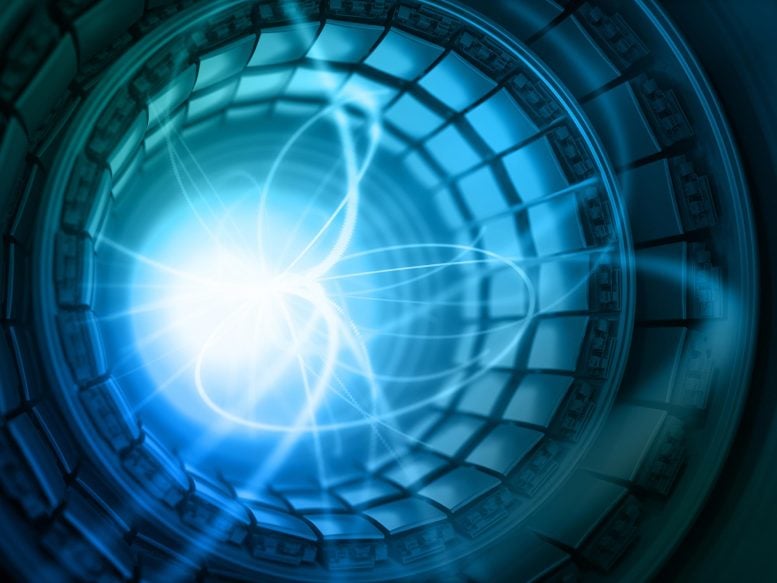
Researchers detail their observation of six neutrino interactions during a pilot run of a compact emulsion detector installed at the LHC in 2018.
Scientific first at CERN facility a preview of upcoming 3-year research campaign.
The international Forward Search Experiment team, led by physicists at the University of California, Irvine, has achieved the first-ever detection of neutrino candidates produced by the Large Hadron Collider at the CERN facility near Geneva, Switzerland.
In a paper published on November 24, 2021, in the journal Physical Review D, the researchers describe how they observed six neutrino interactions during a pilot run of a compact emulsion detector installed at the LHC in 2018.
“Prior to this project, no sign of neutrinos has ever been seen at a particle collider,” said co-author Jonathan Feng, UCI Distinguished Professor of physics & astronomy and co-leader of the FASER Collaboration. “This significant breakthrough is a step toward developing a deeper understanding of these elusive particles and the role they play in the universe.”
He said the discovery made during the pilot gave his team two crucial pieces of information.
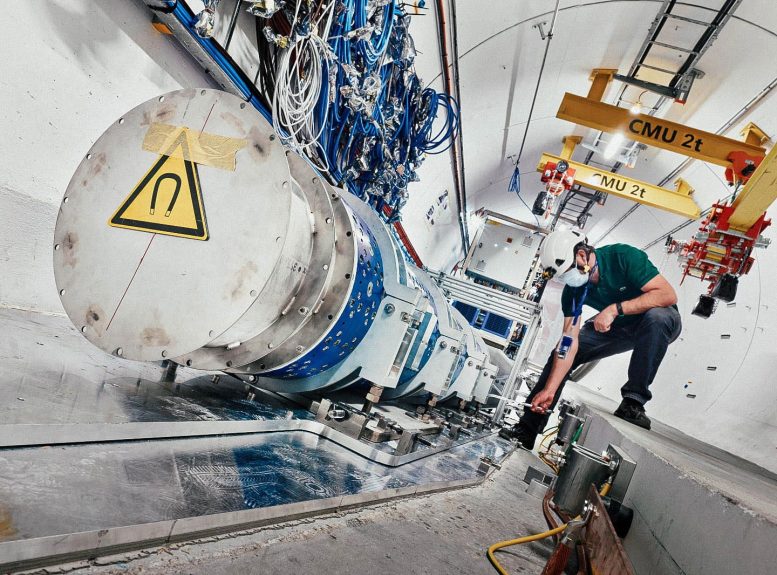
The FASER particle detector that received CERN approval to be installed at the Large Hadron Collider in 2019 has recently been augmented with an instrument to detect neutrinos. The UCI-led FASER team used a smaller detector of the same type in 2018 to make the first observations of the elusive particles generated at a collider. The new instrument will be able to detect thousands of neutrino interactions over the next three years, the researchers say. Credit: Photo courtesy of CERN
“First, it verified that the position forward of the ATLAS interaction point at the LHC is the right location for detecting collider neutrinos,” Feng said. “Second, our efforts demonstrated the effectiveness of using an emulsion detector to observe these kinds of neutrino interactions.”
The pilot instrument was made up of lead and tungsten plates alternated with layers of emulsion. During particle collisions at the LHC, some of the neutrinos produced smash into nuclei in the dense metals, creating particles that travel through the emulsion layers and create marks that are visible following processing. These etchings provide clues about the energies of the particles, their flavors – tau, muon or electron – and whether they’re neutrinos or antineutrinos.
According to Feng, the emulsion operates in a fashion similar to photography in the pre-digital camera era. When the 35-millimeter film is exposed to light, photons leave tracks that are revealed as patterns when the film is developed. The FASER researchers were likewise able to see neutrino interactions after removing and developing the detector’s emulsion layers.
“Having verified the effectiveness of the emulsion detector approach for observing the interactions of neutrinos produced at a particle collider, the FASER team is now preparing a new series of experiments with a full instrument that’s much larger and significantly more sensitive,” Feng said.
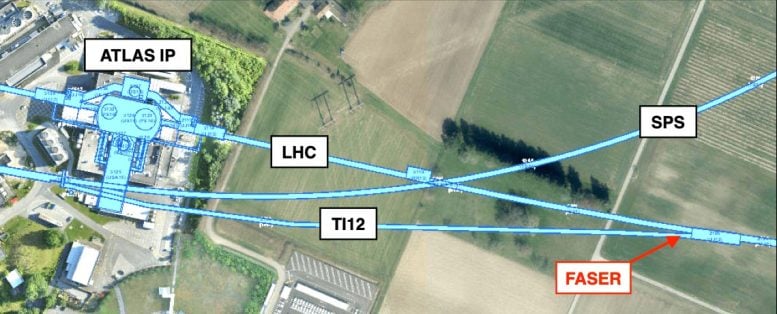
The FASER experiment is situated 480 meters from the ATLAS interaction point at the Large Hadron Collider. According to Jonathan Feng, UCI Distinguished Professor of physics & astronomy and co-leader of the FASER Collaboration, this is a good location for detecting neutrinos that result from particle collisions at the facility. Credit: Photo courtesy of CERN
Since 2019, he and his colleagues have been getting ready to conduct an experiment with FASER instruments to investigate dark matter at the LHC. They’re hoping to detect dark photons, which would give researchers a first glimpse into how dark matter interacts with normal atoms and the other matter in the universe through nongravitational forces.
With the success of their neutrino work over the past few years, the FASER team – consisting of 76 physicists from 21 institutions in nine countries – is combining a new emulsion detector with the FASER apparatus. While the pilot detector weighed about 64 pounds (29 kilograms), the FASERnu instrument will be more than 2,400 pounds (11,00 kilograms), and it will be much more reactive and able to differentiate among neutrino varieties.
“Given the power of our new detector and its prime location at CERN, we expect to be able to record more than 10,000 neutrino interactions in the next run of the LHC, beginning in 2022,” said co-author David Casper, FASER project co-leader and associate professor of physics & astronomy at UCI. “We will detect the highest-energy neutrinos that have ever been produced from a human-made source.”
What makes FASERnu unique, he said, is that while other experiments have been able to distinguish between one or two kinds of neutrinos, it will be able to observe all three flavors plus their antineutrino counterparts. Casper said that there have only been about 10 observations of tau neutrinos in all of human history but that he expects his team will be able to double or triple that number over the next three years.
“This is an incredibly nice tie-in to the tradition at the physics department here at UCI,” Feng said, “because it’s continuing on with the legacy of Frederick Reines, a UCI founding faculty member who won the Nobel Prize in physics for being the first to discover neutrinos.”
“We’ve produced a world-class experiment at the world’s premier particle physics laboratory in record time and with very untraditional sources,” Casper said. “We owe an enormous debt of gratitude to the Heising-Simons Foundation and the Simons Foundation, as well as the Japan Society for the Promotion of Science and CERN, which supported us generously.”
Reference: “First neutrino interaction candidates at the LHC” by Henso Abreu et al. (FASER Collaboration), 24 November 2021, Physical Review D.
DOI: 10.1103/PhysRevD.104.L091101
Savannah Shively and Jason Arakawa, UCI Ph.D. students in physics & astronomy, also contributed to the paper.


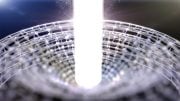
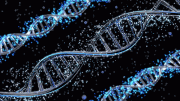
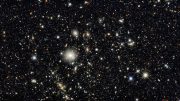
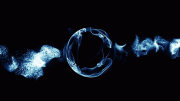
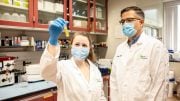
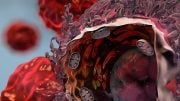
It’d be nice to know what the repeated but undefined “FASER” means.
It’s an acronym for Forward Search Experiment
Take a close look at the Cern logo.. Notice the 666.Theres a statue of the Hindu God Shiva at the HQ. Shiva is the God of destruction. They’re not searching for the God particle. That’s all I’m gonna say you can research it yourselves. The truth is out there.
Seriously? Shiva is the god of destruction but also creation so please do not try to equal Lord Shiva with something evil. Go look for your conspiracies elsewhere and leave religion to the leaders of their religions and science to the scientists.
They already found the God particle? And it’s not like they would somehow be compelled to expose their evil intentions if they were really some devil worshipping group of evil scientist. Why place clues in the logo? Wish we could gather up all the conspiracy theorists on the internet and collide them instead.
How could they balance equations before?
This won’t end well ,god’s laboratory springs to mind
Oh No… CERN has 666 in their logo. Oh No, they found the GOD particle. Oh No, they found the particle of Destruction!
Just because I like pictures of the Goddess ISIS or Axes and Swords does that make me a killer? NO!
Sometimes it’s about Science and the advancement of Humanity as a whole. Can no one accept that sometimes it’s about HUMANITY and our knowledge and survival as a race? Not about the Devil or about Destruction, but about LIFE.
But, I disagree with smashing Conspiracy Theorist together. You could make something NO One wants to deal with. A New Form of Anti-Life or a Bigger Form of just Stupid?
You can’t deny the virus of faith some small battle!